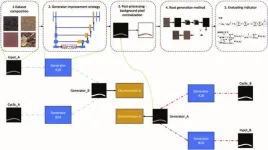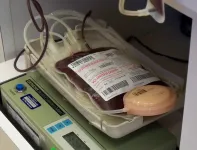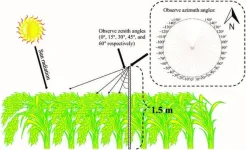(Press-News.org) Researchers have published a simple trick that improves the accuracy of techniques that help us understand how external variables – such as temperature – affect gene activity in plants.
“There are really two contributions here,” says Colleen Doherty, corresponding author of a paper on the work and an associate professor of molecular and structural biochemistry at North Carolina State University. “First, we’re raising the visibility of a problem that many of us in the plant research community were unfamiliar with, as well as highlighting the solution. Second, we’ve demonstrated that addressing this problem can make a significant difference in our understanding of gene activity in plants.”
At issue is a technique called RNA-seq analysis, which is used to measure changes in gene activity – i.e., when genes are actively transcribing to produce proteins.
“We use RNA-seq analysis to assess how plants respond to various stimuli, or changes in their environment,” Doherty says. “It’s used widely because it’s a relatively easy and inexpensive way to monitor plant responses.”
For example, researchers can use RNA-seq analysis to see which genes are turned on when a plant is experiencing drought conditions, which then informs the development of new plant varieties that are drought resistant.
But there’s a specific challenge related to RNA-seq analysis, which Doherty and her collaborators ran into by accident.
“We were monitoring how plants respond to different temperatures at multiple times of day, and the results we got were wildly divergent,” Doherty says. “We initially thought we might be doing something wrong. But when we began looking into it, we learned that animals and yeasts are known to have global changes in transcription based on variables such as the time of day or nitrogen deprivation.”
In other words, researchers want to see how specific variables – such as increased temperature – affect transcription in specific genes. But there are some variables – like time of day – that can increase or decrease transcription in all the genes. This can throw off researchers’ ability to draw conclusions about the specific variables they want to study.
“Luckily, we found that this problem is sufficiently well-established among researchers who work on non-plant species that they have developed a method to account for it, called an artificial spike-in,” Doherty says. “These and similar techniques have been used in plant science in other contexts and when using older techniques and technologies. But for whatever reason, our field didn’t incorporate artificial spike-ins into our methodology when we adopted RNA-seq analysis.”
Artificial spike-ins make use of pieces of foreign RNA that are unlike anything in the plant’s genome, meaning that the foreign RNA will not be confused with anything the plant itself produces. Researchers introduce the foreign RNA into the analysis process at the beginning of the experiment. Because global changes in transcription will not affect the foreign RNA, it can be used as a fixed benchmark that allows researchers to determine the extent to which there is an overall increase or decrease in RNA that the plant itself is producing.
“When we used artificial spike-ins to account for global changes in transcription, we found that the differences in plants exposed to temperature changes at different times of day were actually even greater than we anticipated,” Doherty says.
“The artificial spike-in gave us more accurate information and greater insight into how plants are behaving at night – since we found that global transcription was higher at night. Before we adopted the use of artificial spike-ins, we were missing a lot of what was happening at night.
“Artificial spike-ins are an elegant solution to a challenge many of us in the plant research community didn’t even know was there,” Doherty says. “We’re optimistic this technique will improve the accuracy of transcriptional analysis in the wide variety of conditions that can affect global transcription in plant species. And that, in turn, may help our research community garner new insights into the species we study.
“We didn’t develop this solution – artificial spike-ins – but we really hope it garners more widespread use in plant science.”
The paper, “A normalization method that controls for total RNA abundance affects the identification of differentially expressed genes, revealing bias toward morning-expressed responses,” is published open access in The Plant Journal. First author of the paper is Kanjana Laosuntisuk, a postdoctoral researcher at NC State. The paper was co-authored by Amaranatha Vennapusa of Delaware State University; Impa Somayanda of Texas Tech University; Adam Leman of the Good Food Institute; and SV Krishna Jagadish of Texas Tech University and Kansas State University.
The work was done with support from the Defense Advanced Research Projects Agency, under grant D19AP00026; the National Science Foundation, under grant 2210293; and the Development and Promotion of Science and Technology Talents Project, Thailand.
END
Simple trick could improve accuracy of plant genetics research
2024-03-13
ELSE PRESS RELEASES FROM THIS DATE:
Revolutionizing plant science: a groundbreaking method for expanding in situ root datasets using CycleGAN
2024-03-13
The root system is crucial for plants to absorb water and nutrients, with in situ root research providing insights into root phenotypes and dynamics. While deep-learning-based root segmentation methods have advanced the analysis of root systems, they require extensive manually labeled datasets, which are labor-intensive and time-consuming to produce. Current methods of in situ root observation vary in their effectiveness. Moreover, traditional root image recognition methods face challenges such as subjectivity and ...
COVID-19 rebound after VV116 vs nirmatrelvir-ritonavir treatment
2024-03-13
About The Study: In this randomized clinical trial of 345 patients with mild-to-moderate COVID-19, viral load rebound and symptom rebound were both common after a standard 5-day course of antiviral treatment with either VV116 or nirmatrelvir-ritonavir. Prolongation of treatment duration might be investigated to reduce COVID-19 rebound.
Authors: Yufang Bi, M.D., and Yiping Xu, M.Sc., of the Shanghai Jiao Tong University School of Medicine in Shanghai, China, are the corresponding authors.
To access the embargoed study: Visit our For ...
Mental well-being among adversity-exposed adolescents during the pandemic
2024-03-13
About The Study: The findings of this study of 4,515 adolescents suggest that in-person schooling and several coping behaviors (caring for one’s body, exercising, and engaging in healthy behaviors) were associated with significantly higher positive affect and lower perceived stress during the COVID-19 pandemic among adolescents with high adverse childhood experiences (ACEs). Adolescents with high ACEs demonstrated especially greater mental health scores when they reported in-person schooling. Future studies should build on these findings to identify clinical and school-based mental health protective ...
Enhancing plant photochemistry analysis: a novel approach to chlorophyll a fluorescence measurement under environmental stress
2024-03-13
Chlorophyll a fluorescence (ChlF) has been a pivotal tool in understanding plant photochemistry, offering insights into the energy transfer processes within chloroplasts and the efficiency of Photosystem II (PSII). Researchers have relied on quantifying ChlF through specific measures such as F0, Fm, and Fv under various lighting conditions to assess photosynthetic activities. Nonetheless, the technique encounters obstacles owing to the intrinsic uncertainties in gauging the absolute magnitude of ChlF and the fluctuation in baseline levels affected by environmental conditions. This complicates the interpretation of ...
It’s in the blood: donor diets can trigger allergic reactions in blood recipients
2024-03-13
Allergic transfusion reactions (ATRs), a potentially life-threatening side effect of blood transfusions with unclear mechanisms, may be linked to food allergies in pediatric patients as per a recent study by scientists from Japan. They found that ATRs may be triggered by the presence of allergens in the donor’s blood, influenced by their pre-donation diet. These findings could pave the way for safer blood transfusions through the development of preventive measures and countermeasures for ATRs.
Blood transfusions are often life-saving procedures in various medical settings. They are required not only after severe blood loss ...
Melissa A. Kelly, MS, CGC receives the 2024 ACMG Foundation Carolyn Mills Lovell Genetic Counselor Award
2024-03-13
Melissa A. Kelly, MS, CGC is the recipient of the 2024 ACMG Foundation Carolyn Mills Lovell Genetic Counselor Award. Ms. Kelly received the Lovell award for her platform presentation at the 2024 ACMG Annual Clinical Genetics Meeting, “Integrating genomic medicine into healthcare: Experience disclosing >5,000 clinically relevant results within the Geisinger MyCode Community Health Initiative.”
Ms. Kelly said, “Thank you to the ACMG Foundation. I am humbled and honored to receive the Carolyn Mills Lovell Genetic Counselor Award. Throughout my career, I have seen many ways in which patients and their families interact with and are impacted ...
Rory James Tinker, MD receives the 2024 Richard King Award for Best Publication by a Trainee in Genetics in Medicine
2024-03-13
Rory James Tinker, MD is the recipient of the 2024 Richard King Trainee Award. This award was instituted by the ACMG Foundation for Genetic and Genomic Medicine to encourage American Board of Medical Genetics and Genomics (ABMGG), international equivalents, or genetic counseling trainees in their careers and to foster the publication of the highest quality research in Genetics in Medicine (GIM), an official journal of the ACMG.
Each year the editorial board reviews all articles published in GIM by ...
ACMG Foundation/Revvity 2024 Travel Award presented to Meena Sethuraman, BS
2024-03-13
Meena Sethuraman, BS is the 2024 recipient of the ACMG Foundation/Revvity Travel Award. Ms. Sethuraman was selected to receive the award for her platform presentation, "Characterizing pathogenicity of ACADVL variants in very long-chain acyl-CoA dehydrogenase deficiency.”
Meena Sethuraman is a third-year medical student in the Physician Scientist Training Program at the University of Pittsburgh School of Medicine. Her research, being conducted with Dr. Jerry Vockley, FACMG, involves studying genetic variants in fatty acid oxidation disorders. Meena previously received her BS in Neurobiology at the University of Washington. Her undergraduate and post-baccalaureate ...
The ACMG Foundation for Genetic and Genomic Medicine presents seven Next Generation fellowship awards at the 2024 ACMG Annual Clinical Genetics Meeting
2024-03-13
Each year, the ACMG Foundation for Genetic and Genomic Medicine grants its Next Generation fellowship awards to promising early career professionals in a range of medical genetics and genomics specialties including Clinical Biochemical Genetics Laboratory, Laboratory Genetics and Genomics, Medical Biochemical and Ophthalmic Genetics. Support for this year’s class of Fellows was generously provided by Pfizer, Sanofi, Spark Therapeutics, Bionano and Horizon Therapeutics. The ACMG Foundation depends on corporate ...
Enhancing crop productivity analysis: a novel approach using SIF and PRI for accurate GPP estimation in rice canopies
2024-03-13
Solar-induced chlorophyll fluorescence (SIF) and the photochemical reflectance index (PRI) have emerged as significant tools in assessing the photosynthetic and carbon sequestration capacities of terrestrial vegetation, particularly for estimating gross primary productivity (GPP). However, the relationship between SIF, PRI, and GPP encounters challenges due to large temporal and spatial variabilities as well as the influence of various observational factors such as canopy structure and physiological state. Despite the potential of multi-angle observations and the Bidirectional Reflectance Distribution Function (BRDF) model to mitigate these ...



